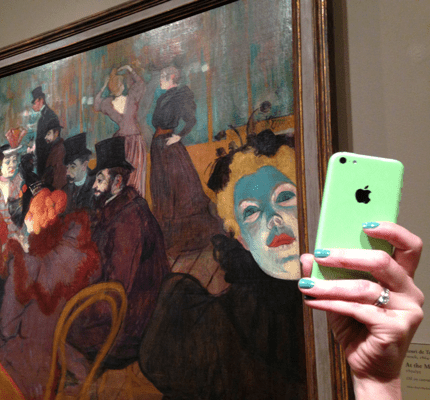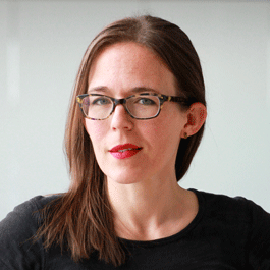
The Art of Museum Selfies: Disrupting Spectatorship with Performance
Until well into the 19th century, visitors could touch artwork and exhibits in museums, thereby furthering their engagement with sculptures, textiles, and paintings. But in the 20th century, museums began to create multiple types of barriers that restrict sensory access to visual engagement only, leaving visitors wanting more.
In a new article in NCA’s Text and Performance Quarterly, E.B. Hunter of Northwestern University explores how in the 21st century, museum visitors use selfies to “disrupt the narrative of the museum and to activate the age-old topos of an artwork coming to life.” Hunter explains how museum selfies function as three forms of capital: economic, cultural, and social. She breaks down example images found online and taken on her own visit to the Art Institute of Chicago to illustrate museum selfies’ performative functionality. Hunter writes, “Through this disruption, museum selfie takers assert their physical bodies and online personae as curated objects equally deserving of a viewer’s interest and focus.”
#MuseumSelfies: A Study of Art, Access, and Capital
On #MuseumSelfieDay in 2016, more than 34,000 tweets generated 287 million impressions worldwide. Hunter argues that “the intrusion of the live visitor’s body into the frame of a museum selfie and the broad social media circulation of the resulting photograph add a new layer of interactivity to digital-age museum spectatorship.” Museum selfie-taking shouldn’t be dismissed simply as evidence of narcissism – it also functions to provide evidence of economic capital as it relates to museum fees and leisure time, travel destinations, and access to smartphones. “A museum selfie from the Sumida Hokusai Museum in Tokyo,” the author writes, “implies a higher price tag if the selfie taker is from Alabama than if from South Korea.” Moreover, she notes that despite widespread access to smartphones, “subtler indications of economic capital linger in features like pixel resolution or the absence of other visitors on the background of private tour selfies.”
Further, museum selfies are evidence of the selfie taker’s cultural capital, which is “a qualitative measure that depends on the sensibilities and subject area expertise of each selfie viewer.” According to Hunter, taking a selfie at a museum creates a different narrative about and perception of the selfie taker than if the photo were taken at a dog fight, for example. Finally, Hunter asserts that museum selfies particularly illuminate social capital, thanks to such social media metrics as likes and retweets. She compares her own social capital as a theater scholar to that of singer Beyoncé, who has more than 15 million Twitter followers and has been known to “break the internet” on many occasions, including during a private tour at a museum. “I have less social capital than Beyoncé, so my museum selfies from the Art Institute of Chicago did not commensurately ‘break the internet,’” Hunter writes.
Museum Selfies as Performance and a Path to Visitor Insights
Hunter posits that spectatorship in a museum is not just about viewing art—it’s also about becoming the art, with or without a smartphone. “Visitors view objects on display in view of other visitors, observing their viewing practices even as they are aware of being viewed in return,” she writes. And, thanks to the social media and selfie culture, museum spectators know how to leverage this performance to demonstrate and increase their social capital. Thus, while spectators may visit a museum to see objects on display, Hunter argues that museum selfies offer an additional motivation – “to be one of the things seen there.”
Hunter also notes that museums may find uses for museum selfies. They can examine the images for “visitor-generated insights into the intentions, values, and responses of tech-enabled patrons, capturing data that museum-generated surveys might obscure.” Particularly, museum selfies “create a digital archive of the many ways visitors intervene in the museum’s use of exhibition and curatorial treatment.”
Selfies in the Field: An Experiment
The author details her visit to the Art Institute of Chicago to gain “considerable insights into the technical difficulty, the social danger, and the esthetic glee of making great works of art look as if they are taking selfies with a lime green iPhone.” Hunter breaks down various attempts to get the right angle, lighting, and pose with art on display, and the hyper-awareness and tension created because of touch panic from museum guards, time, and other visitors’ reactions. “After rushing to get a shot, the anticipating of seeing whether the effect came off is intoxicating,” she notes. “When a museum selfie works, the sense of ownership and disrupted poetics is potent.”
So what does this mean for museums seeking to leverage the increasing #MuseumSelfie movement? Hunter says museum selfies can be a bridge between established collections and a digitally-engaged public that is “attuned to interactivity as meaning-making.” Museum selfies represent an opportunity for institutions, large and small, to increase attendance and visitor engagement, and to open a dialogue in new ways. Ultimately, Hunter argues, “Museum selfies remind us that museums are places – real places, with physical addresses – that we want to visit.”


